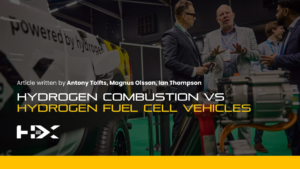
As the automotive industry transitions towards sustainable energy sources, hydrogen has emerged as a leading alternative to traditional fossil fuels. At H2X Global, we are at the forefront of this shift, specializing in Hydrogen Fuel Cell Electric Vehicles (FCEVs). This article provides a professional comparative analysis of hydrogen combustion engines and hydrogen fuel cell vehicles, emphasizing the advantages and challenges of each technology.
Historical Context
Since the 1920s, Internal Combustion Engine (ICE) vehicles powered by gasoline and diesel have dominated the automotive landscape. However, the environmental impact of fossil fuels has necessitated the search for cleaner, more sustainable alternatives. Hydrogen, with its potential for zero-carbon emissions, has become a pivotal element in this pursuit.
For automotive businesses, the transition from fossil fuels to electrified vehicles has become a global trend, particularly for personal vehicles. However, larger vehicles have encountered significant challenges with Battery Electric Vehicles (BEVs), such as extended charging times and the weight of batteries, which compromise runtime and cargo capacity.
Hydrogen, a zero-carbon fuel compressed to 350 or 700 bar in specially designed tanks onboard the vehicle, offers a viable solution. It provides energy in a manner similar to gasoline or diesel tanks in traditional vehicles. Given that hydrogen’s distribution and refuelling infrastructure closely mirror that of conventional fuels, it is particularly appealing for businesses with time-critical operations. Importantly, both hydrogen combustion and fuel cell vehicles can be refuelled at the same stations.
Hydrogen Combustion Engines (H2-ICE)
Hydrogen combustion engines function similarly to traditional ICEs but use hydrogen as fuel instead of gasoline or diesel. This approach leverages existing ICE technology, providing a familiar and tested alternative for many companies.
Hydrogen Fuel Cell Electric Vehicles (FCEVs)
FCEVs convert hydrogen into electricity through a chemical reaction within a fuel cell, emitting only water and heat as byproducts. This technology offers a fundamentally different approach compared to combustion engines, emphasizing electric propulsion.
Comparative Analysis
| Aspect | Hydrogen Combustion Engines (H2-ICE) | Hydrogen Fuel Cell Electric Vehicles (FCEVs) |
| Emissions | Trace amounts of CO2 and NOx, requiring exhaust treatments | Zero emissions, only water and heat |
| Efficiency | Lower efficiency, requires more hydrogen for the same range | Higher efficiency, less hydrogen needed for the same range |
| Technology | Utilizes well-established ICE technology | Emerging technology with ongoing development |
| Hydrogen Purity | Can operate with lower-quality hydrogen | Requires high-purity hydrogen for optimal performance |
| Power Output | Effective at higher loads, capable of producing substantial power | Consistent power output with regenerative braking |
| Maintenance | Similar to traditional ICE vehicles | Fewer moving parts, leading to lower maintenance costs |
| Adoption | Easier to adopt due to familiar technology | Still in early stages of widespread adoption |
| Fuel Type | Hydrogen (Zero carbon-based) | |
| Fuel Delivery System | Onboard H2 tanks at 350Bar or 700Bar | |
| Refuelling Infrastructure | Shared Hydrogen stations infrastructure | |

Conclusion
H2X Global is committed to advancing hydrogen fuel cell technology, recognizing its superior benefits in terms of efficiency, zero emissions, and reduced maintenance. While hydrogen combustion engines offer a familiar and immediate solution, H2X believe the future of sustainable transportation lies in the adoption of FCEVs. By focusing on “back to base” logistic vehicle fleets such as utility vehicles (Utes), buses, trucks, delivery vans, and taxis.
H2X are driving the change towards zero-emission transportation, with hydrogen technology leading the way, follow us to be a part of this journey.